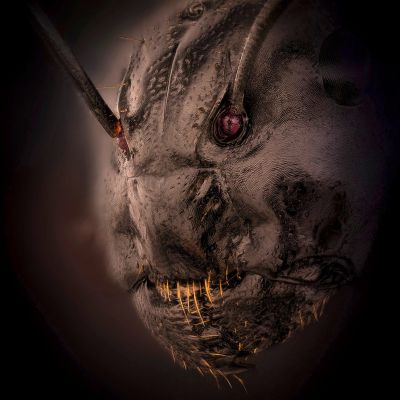Is this ant terrifying or beautiful? Depends who you ask.

There are an estimated 20 quadrillion ants all over the planet, except in Antarctica – a bummer, considering the continent’s name.
But a close-up shot of a carpenter ant that started making the rounds last week bears almost no resemblance to the cutesy, cartoonish faces brought to life in films like Disney/Pixar’s “A Bug’s Life” or DreamWorks’ “Antz.” Instead, the image by Lithuanian photographer Eugenijus Kavaliauskas is reminiscent of a horror movie, with the carpenter ant’s antennae poking out of eerie red circles and its jaw looking like an alien’s saber-toothed grin.
The photo – which was honored with a distinction in Nikon’s 2022 Small World Photomicrography Competition – was quickly dubbed by Twitter users as nightmare fuel.
Yet for Kavaliauskas, the photo he captured by magnifying an ant’s face five times under a stereo 10x microscope is an example of “God’s designs and the many interesting, beautiful, unknown miracles under people’s feet,” he said.
A lover of all things nature, Kavaliauskas began his wildlife photography career by shooting images of birds of prey – including some that earned him awards. But four years ago, a desire to unearth the world’s secrets, a passion for the “unseen angle” and lessons from his friend and fellow photographer Saulius Gugis inspired him to take on photomicrography, or capturing images under a microscope. The craft completely changed his outlook, he said.
“There are no horrors in nature, only lack of knowledge,” Kavaliauskas said. “When I began photomicrography and before that, I was like everyone else – all beetles and insects were monsters to me. Now the situation has turned upside down. Many insects are not as pleasing to the eye as a cat, but it all depends on your point of view.”
The idea to photograph a carpenter ant – a species that chews through wood to engineer tunnels for its nests – came by looking at the little bugs crawling in the trees in the forest near his home in Tauragė, Lithuania. He landed on the image by playing around with the shadows and light hitting the ant’s face.
The zoomed-in photo actually makes the ant look a bit more menacing than it should. For instance, the red spheres in the ant’s seemingly sneering face aren’t its eyes, which are hidden in the shot; they’re where its antennae start. And the sharp-looking things coming out of its jaw are actually teeny-tiny trigger hairs, used to communicate and sense the environment around them.
“If you would’ve taken a picture of that same ant’s head just a little bit farther back, it would have been almost cute,” said Miles Maxcer, a National Science Foundation graduate research fellow with the University of Florida’s department of entomology and nematology. “I swear some ants can be really cute and fuzzy!”
Where some find horror, scientists see a species that helps plants disperse, aerates soil and keeps ecosystems clean by acting as a sort of top-notch waste disposal and recycling service.
Even if the carpenter ant isn’t a stunner – or, say, as adorable as a golden retriever puppy – it’s cute in other ways, said Maxcer, who’s also the director of the Ant Network, a science communication organization.
Carpenter ants have an “almost domesticated relationship” with aphids, tiny bugs that suck plants’ juices and then turn them into honeydew, a sugary liquid they secrete that’s an important source of food for carpenter ants. Aphids, he said, are “the most pathetic defender of its own body,” so carpenter ants take it upon themselves to protect them from predators, guide them and keep them warm during the winter months.
“What these ants do is farm the aphids, kind of like how humans farm cattle,” Maxcer said. “We protect our dairy cows, we feed them, we make sure that nothing’s going to hurt them, and in return we get milk. Well, carpenter ants do the same, but they get honeydew.”
Maxcer said ants are great engineers, taking on incredibly complex architecture to build their nests. They also dabble in agriculture by cultivating fungi and are extremely social creatures, with organized colonies that could rival any major city.
And ants – though slightly terrifying up close – are considered a “keystone species,” or an instrumental organism that acts like the glue keeping a habitat together.
“What ants do in ecosystems is really far-ranging,” Maxcer said. “If you took ants out of most ecosystems around the world, you would see them change dramatically and, in some instances, collapse.”
Might want to keep that in mind before squishing one – or losing sleep over that haunting photo.